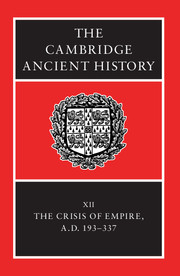Book contents
- Frontmatter
- PART I NARRATIVE
- PART II GOVERNMENT AND ADMINISTRATION
- PART III THE PROVINCES
- PART IV THE ECONOMY OF THE EMPIRE
- PART V THE NON-ROMAN WORLD
- 13 The Germanic peoples and Germanic society
- 14 The Sassanians
- 15 Armenia and the eastern marches
- 16 The Arabs and the desert peoples
- PART VI RELIGION, CULTURE AND SOCIETY
- Chronology
- Bibliography
- Index
- Topographical map of the Roman empire
- Map 2 The Roman empire in a.d. 211
- The Roman empire in a.d. 314
- The Rhine–Danube limes in the late second century
- References
14 - The Sassanians
from PART V - THE NON-ROMAN WORLD
Published online by Cambridge University Press: 28 March 2008
- Frontmatter
- PART I NARRATIVE
- PART II GOVERNMENT AND ADMINISTRATION
- PART III THE PROVINCES
- PART IV THE ECONOMY OF THE EMPIRE
- PART V THE NON-ROMAN WORLD
- 13 The Germanic peoples and Germanic society
- 14 The Sassanians
- 15 Armenia and the eastern marches
- 16 The Arabs and the desert peoples
- PART VI RELIGION, CULTURE AND SOCIETY
- Chronology
- Bibliography
- Index
- Topographical map of the Roman empire
- Map 2 The Roman empire in a.d. 211
- The Roman empire in a.d. 314
- The Rhine–Danube limes in the late second century
- References
Summary
INTRODUCTION
The circumstances of the last years of Parthian rule and the rise of the Sassanians are not well known because of scanty and conflicting information in our sources. Unfortunately the second century of our era in the east is especially dark even though it was a time of great change from the past. In the realm of native written sources alone, for example, we have inscriptions from the middle Parthian period dating from the first century of our era in Nisa (present Turkmenistan) and Avroman (in Kurdistan) which have been characterized as written in degenerate Aramaic, whereas in the third century the Parthian versions of inscriptions of early Sassanian rulers can be read only as Parthian. This is an indication of a change from a continuation of the past to a new world, which is further suggested by the change from a ‘feudal’ Parthian state to a centralized Sassanian empire. Furthermore, the state of Zoroastrianism under the Parthians as a loosely organized company of priests contrasts sharply with the hierarchically formed state church of the Sassanians. Briefly, the later Parthian age may be characterized roughly as a time of many semi-independent principalities, varieties of religious expression and flourishing trading centres, such as Petra, Palmyra, Hatra and Spasinou Charax on trade routes leading to the Persian gulf and India. The Sassanian empire, on the other hand, had a centralized court and bureaucracy with a state church organization paralleling the hierarchy of the state, and the trading centres, especially the ‘caravan cities’ as Rostovtzeff called them, were destroyed or absorbed into either the Roman or Sassanian empires.
- Type
- Chapter
- Information
- The Cambridge Ancient History , pp. 461 - 480Publisher: Cambridge University PressPrint publication year: 2005
References
- 5
- Cited by

